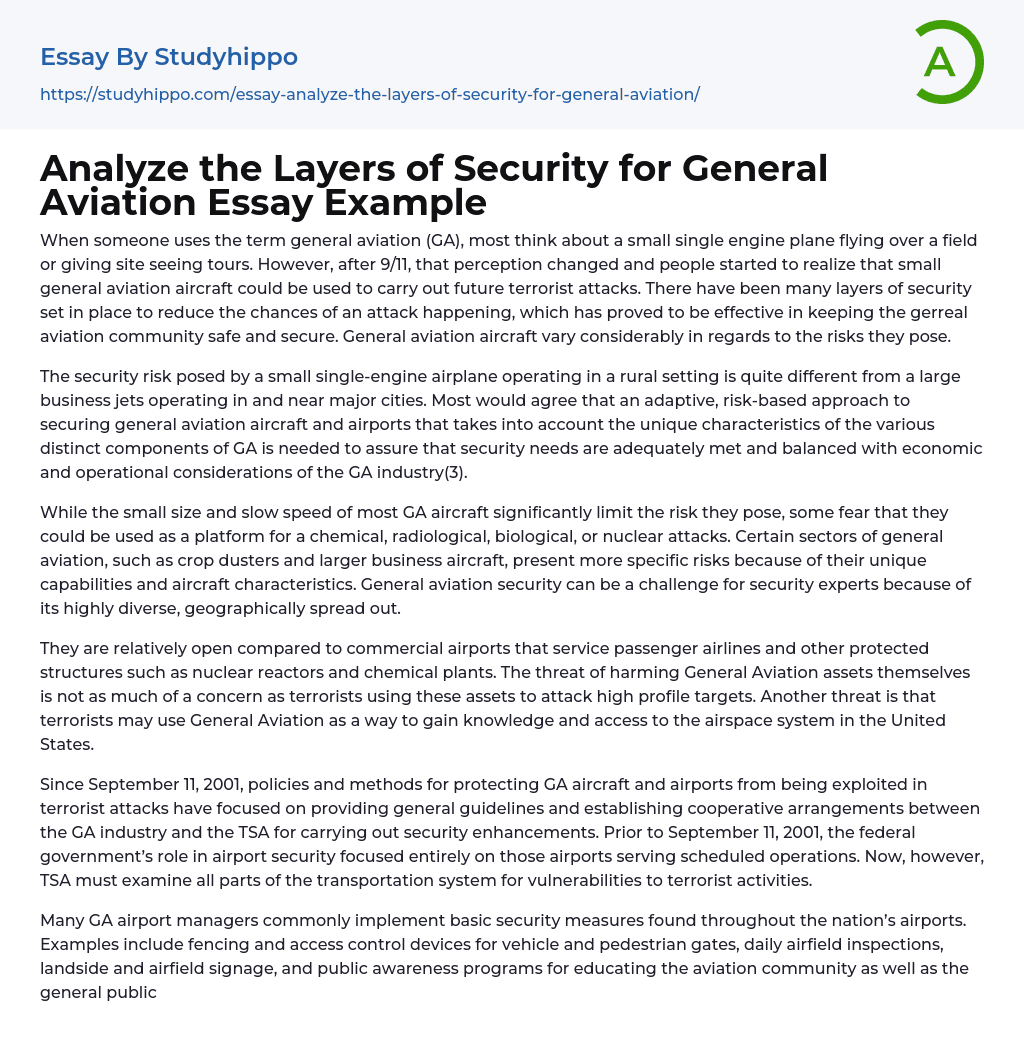

Analyze the Layers of Security for General Aviation Essay Example
When someone uses the term general aviation (GA), most think about a small single engine plane flying over a field or giving site seeing tours. However, after 9/11, that perception changed and people started to realize that small general aviation aircraft could be used to carry out future terrorist attacks. There have been many layers of security set in place to reduce the chances of an attack happening, which has proved to be effective in keeping the gerreal aviation community safe and secure. General aviation aircraft vary considerably in regards to the risks they pose.
The security risk posed by a small single-engine airplane operating in a rural setting is quite different from a large business jets operating in and near major cities. Most would agree that an adaptive, risk-based approach to securing general aviation aircraft and airports that takes into
...account the unique characteristics of the various distinct components of GA is needed to assure that security needs are adequately met and balanced with economic and operational considerations of the GA industry(3).
While the small size and slow speed of most GA aircraft significantly limit the risk they pose, some fear that they could be used as a platform for a chemical, radiological, biological, or nuclear attacks. Certain sectors of general aviation, such as crop dusters and larger business aircraft, present more specific risks because of their unique capabilities and aircraft characteristics. General aviation security can be a challenge for security experts because of its highly diverse, geographically spread out.
They are relatively open compared to commercial airports that service passenger airlines and other protected structures such as nuclea
reactors and chemical plants. The threat of harming General Aviation assets themselves is not as much of a concern as terrorists using these assets to attack high profile targets. Another threat is that terrorists may use General Aviation as a way to gain knowledge and access to the airspace system in the United States.
Since September 11, 2001, policies and methods for protecting GA aircraft and airports from being exploited in terrorist attacks have focused on providing general guidelines and establishing cooperative arrangements between the GA industry and the TSA for carrying out security enhancements. Prior to September 11, 2001, the federal government’s role in airport security focused entirely on those airports serving scheduled operations. Now, however, TSA must examine all parts of the transportation system for vulnerabilities to terrorist activities.
Many GA airport managers commonly implement basic security measures found throughout the nation’s airports. Examples include fencing and access control devices for vehicle and pedestrian gates, daily airfield inspections, landside and airfield signage, and public awareness programs for educating the aviation community as well as the general public on the safe and secure use of the facility. GA airport managers may find it helpful to develop written security procedures. Many of these security measures are already being conducted on airfields but some have not made them into an official documented program.
Documentation provides managers with a traceable and auditable method of ensuring airport employees and tenants are aware of and understand security issues. Such a protocol should minimally consist of, but not be limited to, airport and local law enforcement contact information, including alternates when available, and utilization of a program
to increase airport user awareness of security precautions such as Airport Watch. Since most security procedures may contain sensitive information, the airport operator should limit access to them to the extent possible.
While surveillance, access controls, and physical security measures at airports can provide effective deterrents these measures may be costly and challenging to implement at many GA airports. Measures to physically secure aircraft can be viewed as either an additional layer of security to prevent theft and unauthorized access to aircraft at airports with extensive surveillance and access controls or as a primary means of security at some airports with more limited security capabilities.
Physical security measures for aircraft may include cabin and ignition locks that may already exist for certain aircraft as well as supplemental immobilizing devices such as propeller, throttle, control surface, and tie-down locks. Securing agricultural aviation operations has become an important in the General Aviation sector. Because agricultural aviation operations usually take place in rural environments, increased awareness of this threat along with operators increasing their attentiveness and taking steps to secure their aircraft may reduce the chances of something bad happening.
Airplanes and helicopters used to perform aerial applications have made them specifically attractive to terrorists. For this reason TSA has recommended to operators of agricultural aircraft that they use multiple security device such as throttle and control locks, propeller locks, and hidden ignition switches to secure aircraft, store aircraft in hangars with electronic security systems and steel doors, and when hangars are not available, park heavy equipment in a manner to prevent the movement of aircraft.
- Internet Privacy essays
- Cyber Security essays
- Code of Ethics essays
- Conflict essays
- Dress Code essays
- Human Resources essays
- Organizational Behavior essays
- Performance essays
- Recruitment essays
- Safety essays
- Agreement essays
- Business Law essays
- Common Law essays
- Community Policing essays
- Constitution essays
- Consumer Protection essays
- Contract essays
- Contract Law essays
- Copyright Infringement essays
- Court essays
- Crime essays
- Criminal Law essays
- Employment Law essays
- Family Law essays
- Injustice essays
- Judge essays
- Jury essays
- Justice essays
- Lawsuit essays
- Lawyer essays
- Marijuana Legalization essays
- Ownership essays
- Police essays
- Property essays
- Protection essays
- Security essays
- Tort Law essays
- Treaty essays
- United States Constitution essays
- War on Drugs essays



